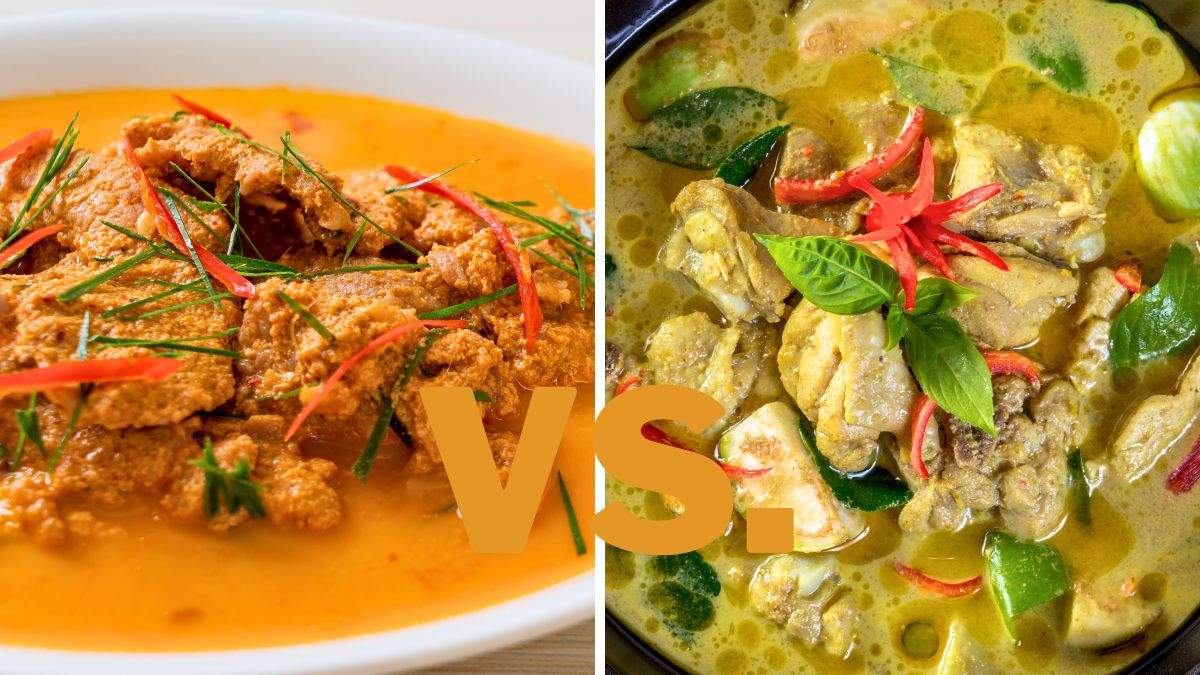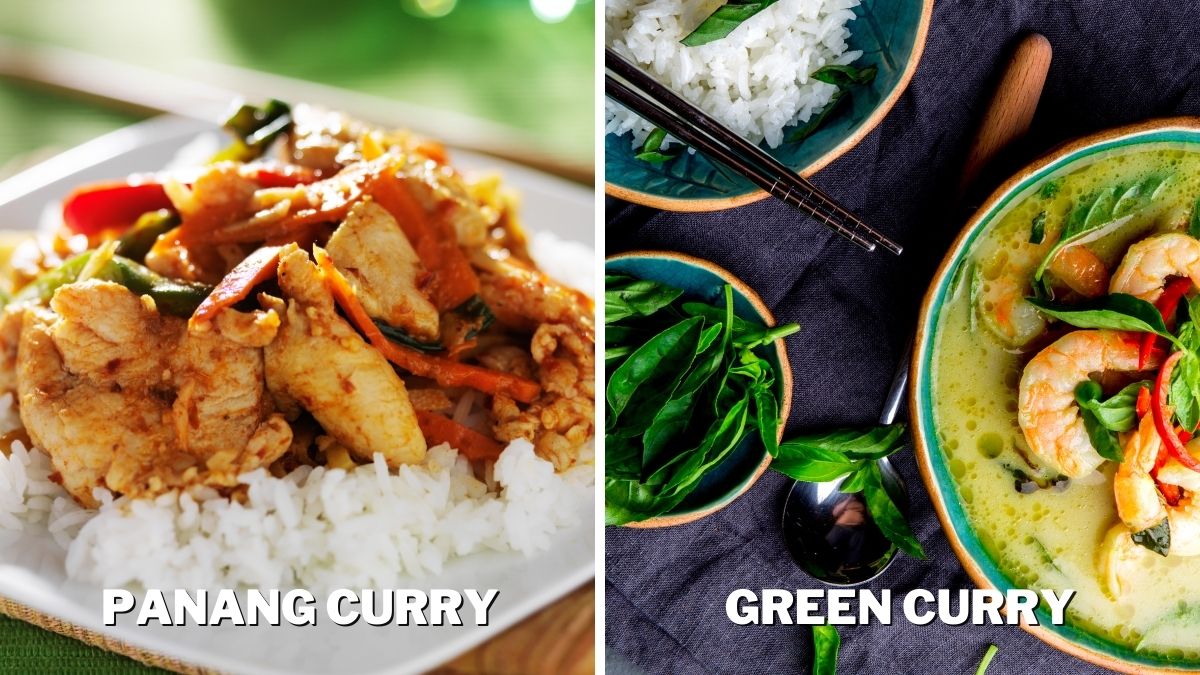Panang Curry vs. Green Curry: Differences & Which Is Better

Thai curries are some of my favorite dishes, with their creamy coconut-based sauces and flavorful blend of spices. Two of the most popular types are panang curry and green curry. If you’re like me and can’t decide which to order at your local Thai restaurant, then some key differences between these curries are worth noting.
By the end of this, you’ll know exactly which curry is the right choice for your palate. So, read on as I break down how these curries compare on origins, ingredients, taste, and more!
What Is Panang Curry?
This delicious curry originates from Malaysia and is richer, sweeter, and nuttier than the other spicier Thai curries. The word “panang” refers to a thick coconut-based sauce enriched with peanuts or cashews.
The peanutty coconut sauce is creamy and satisfying, with warm spices like cinnamon or clove complementing the heat of the chilies. This curry is usually milder, though you can request extra spice. It has the nutty, mellow flavor and texture of roasted peanuts ground right into the curry paste.
The mix of sweet and savory flavors blended into a rich coconut sauce creates a fantastic combination.
Is It the Same as Red Curry?

Panang curry is not the same as red curry, though they do share some similarities. These two originate from different regions of Thailand, though both feature a coconut milk base and chili peppers.
Panang curry hails from southern Thailand and the main ingredients are peanuts, palm sugar, and spices like coriander and cumin, but there are many different versions. On the other hand, red curry comes from central Thailand and relies more on dried red chilies for heat and flavor.
While they may look alike, if you take a bite, you’ll notice that panang has a thicker, sweeter sauce with hints of peanut. Red curry packs more heat from fresh chilies and has a thinner, tangier sauce.
What Is Green Curry?
Green curry is one of the most popular Thai curries. As the name suggests, it gets its signature color from green chilies and herbs like basil, cilantro, and mint.
The base is coconut milk infused with green chilies, shallots, garlic, and galangal or ginger. The chilies provide heat, while basil adds an aromatic, licorice-like flavor. Cilantro gives it a citrusy kick. The blend of spices used can vary but typically includes coriander seeds, cumin, and peppercorns. Also, it’s usually made with chicken, beef, or seafood.
Comparing Panang Curry and Green Curry
Unlike panang curry, which is richer and creamier, green curry has a fresher, tangier flavor from the blend of herbs and spices. The herbs make it intensely fragrant, with floral notes reminiscent of a tropical jungle. To make the right choice between the two, you need to have all the facts, so here they are!
Distinct Origins
We are talking about two of Thailand’s most popular curries but with different origins.
I’ve always thought panang was just a type of red curry, but it actually has its own unique flavor profile. It originates from southern Thailand and is usually made with coconut milk, chili peppers, and peanuts.
On the other hand, green curry comes from central Thailand. What makes it unique is not only its color but also its signature flavor.
Key Ingredients That Set Them Apart
Panang curry’s signature ingredient is panang curry paste, made from dried chilies, shallots, garlic, galangal, lemongrass, coriander seeds, cumin, and peppercorns.
Unlike the fresher-tasting green curry paste, this curry paste is roasted before being ground into a paste, giving it an earthier, smokier flavor.
Coconut milk provides the creamy base for both curries, but panang curry also contains peanuts, adding savory nuttiness.
Green curry paste, on the other hand, is made from green chilies, shallots, lemongrass, galangal, coriander seeds, cumin seeds, and shrimp paste.
So, green curry includes green curry paste combined with bamboo shoots, bell peppers, and fresh basil, resulting in a spicier, more vibrant taste with herbal notes from the basil.
| Panang Curry | Green Curry |
|---|---|
| Coconut milk, peanuts, panang curry paste with dried chilies, shallots, garlic, lemongrass, and cumin. | Coconut milk, green curry paste with spicy fresh green chilies, bell peppers, bamboo shoots, cilantro, fresh basil, and other herbs. |
Cooking Methods: Sautéing Panang Curry vs. Grinding Green Curry
Panang curry paste is usually sautéed in coconut milk to make the curry sauce. The paste contains dried chilies, shallots, garlic, galangal, lemon grass, coriander seeds, and peppercorns.
Compared to the green curry, this paste has a thicker consistency. It is usually cooked longer to allow the flavors to blend and develop.
On the other hand, green curry is made with fresh green chilies, so it tends to be spicier. The ingredients are ground to make the paste, and the paste is then stir-fried in coconut milk to make the delicious final product!
Flavor Profiles and Appearance
When it comes to taste, panang curry definitely delivers a richer, nuttier experience with its coconut milk and peanut base.
The peanuts give it a creamy, peanutty flavor that is slightly sweet and savory. The curry itself has a thick, creamy coconut milk base with a vibrant orange-red hue from the chili peppers.
On the other hand, green curry is just like its name says — green. It has a fresher, tangier flavor from ingredients like green chilies, lime leaves, basil, and cilantro. The coconut milk base is thinner, and the overall flavor profile is more citrusy and herbaceous.
For some, green curry can be quite spicy, and it can in no way be categorized as mild. Both curries are usually garnished with cilantro, but panang may also have lime wedges, chopped peanuts, or crispy shallots.
| Panang Curry | Green Curry |
|---|---|
| Richer, nuttier flavor. Sweet and savory with an orange-red color and thicker consistency. | Fresher, tangier, and spicier flavor, more citrusy with green color. |
Not-so-Different Serving Styles

Panang curry is generally served as a thick, creamy sauce, almost like a curry stew. It clings well to rice and vegetables. Green curry, on the other hand, tends to be soupier. It’s meant to be spooned over rice but can also function like a broth. The coconut milk and spices create an aromatic liquid that fish, chicken, or vegetables can swim in.
Both curries are usually accompanied by rice to soak up the flavorful sauces. But if I want a heartier meal, panang curry is my go-to. The thicker consistency is also ideal for mixing in with noodles like rice noodles or egg noodles. Green curry can work with noodles, too; you may just need to reduce the amount of broth.
Spiciness Levels: Mild Panang Curry vs. Green Curry with a Punch
Panang curry tends to be milder, with the chilies used more for flavor than heat. The creamy coconut milk and peanut sauce help temper any spiciness from the chilies. For me, panang curry has a lovely warmth without being too fiery.
In contrast, green curry can pack more of a punch. Green chilies are central to its flavor and provide most of the heat. The paste also contains shallots, lemongrass, galangal, and spices, but the fresh chilies are the star of the show.
Green curry can range from moderately spicy to quite incendiary, depending on the number and type of chilies used. I find it a touch too spicy for my taste, though the flavor of the basil, bell peppers, and other veggies comes through.
Similarities Between These Dishes
Both curries start with a base of coconut milk, chili peppers, and Thai curry paste. Moreover, while these two curries have quite a few notable differences, they also have some similarities.
They contain common ingredients like shallots, lemongrass, galangal, and fish sauce. And, of course, they are usually served over rice with fresh lime wedges.
Which Is a Better Choice, Panang Curry or Green Curry?
Panang curry is probably your best bet if you prefer a milder curry. Green curry may be more appealing for more adventurous palates that can handle the heat. Ultimately, you can’t go wrong with either — you can always adjust the spiciness to your desired level of sizzle!
Personally, I prefer panang because it’s usually thicker and richer, perfect for spooning over rice, and the flavor profile better suits my taste buds better. This is because I generally prefer a curry with some kick, but not so much that it overwhelms the other flavors.
At the end of the day, it comes down to personal taste. The best way to go would be to try out both, and then decide which one is better for you. Either way, you can’t go wrong with these classic Thai flavors.
If you have already tried both, which one do you like better? I’m excited to hear from you, so make sure to share your thoughts in the comments below!
